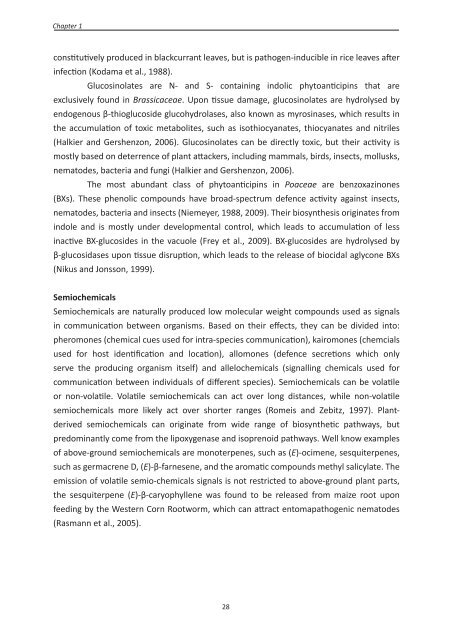Plant basal resistance - Universiteit Utrecht
Plant basal resistance - Universiteit Utrecht
Plant basal resistance - Universiteit Utrecht
Create successful ePaper yourself
Turn your PDF publications into a flip-book with our unique Google optimized e-Paper software.
Chapter 1<br />
constitutively produced in blackcurrant leaves, but is pathogen-inducible in rice leaves after<br />
infection (Kodama et al., 1988).<br />
Glucosinolates are N- and S- containing indolic phytoanticipins that are<br />
exclusively found in Brassicaceae. Upon tissue damage, glucosinolates are hydrolysed by<br />
endogenous β-thioglucoside glucohydrolases, also known as myrosinases, which results in<br />
the accumulation of toxic metabolites, such as isothiocyanates, thiocyanates and nitriles<br />
(Halkier and Gershenzon, 2006). Glucosinolates can be directly toxic, but their activity is<br />
mostly based on deterrence of plant attackers, including mammals, birds, insects, mollusks,<br />
nematodes, bacteria and fungi (Halkier and Gershenzon, 2006).<br />
The most abundant class of phytoanticipins in Poaceae are benzoxazinones<br />
(BXs). These phenolic compounds have broad-spectrum defence activity against insects,<br />
nematodes, bacteria and insects (Niemeyer, 1988, 2009). Their biosynthesis originates from<br />
indole and is mostly under developmental control, which leads to accumulation of less<br />
inactive BX-glucosides in the vacuole (Frey et al., 2009). BX-glucosides are hydrolysed by<br />
β-glucosidases upon tissue disruption, which leads to the release of biocidal aglycone BXs<br />
(Nikus and Jonsson, 1999).<br />
Semiochemicals<br />
Semiochemicals are naturally produced low molecular weight compounds used as signals<br />
in communication between organisms. Based on their effects, they can be divided into:<br />
pheromones (chemical cues used for intra-species communication), kairomones (chemcials<br />
used for host identification and location), allomones (defence secretions which only<br />
serve the producing organism itself) and allelochemicals (signalling chemicals used for<br />
communication between individuals of different species). Semiochemicals can be volatile<br />
or non-volatile. Volatile semiochemicals can act over long distances, while non-volatile<br />
semiochemicals more likely act over shorter ranges (Romeis and Zebitz, 1997). <strong>Plant</strong>-<br />
derived semiochemicals can originate from wide range of biosynthetic pathways, but<br />
predominantly come from the lipoxygenase and isoprenoid pathways. Well know examples<br />
of above-ground semiochemicals are monoterpenes, such as (E)-ocimene, sesquiterpenes,<br />
such as germacrene D, (E)-β-farnesene, and the aromatic compounds methyl salicylate. The<br />
emission of volatile semio-chemicals signals is not restricted to above-ground plant parts,<br />
the sesquiterpene (E)-β-caryophyllene was found to be released from maize root upon<br />
feeding by the Western Corn Rootworm, which can attract entomapathogenic nematodes<br />
(Rasmann et al., 2005).<br />
28

















